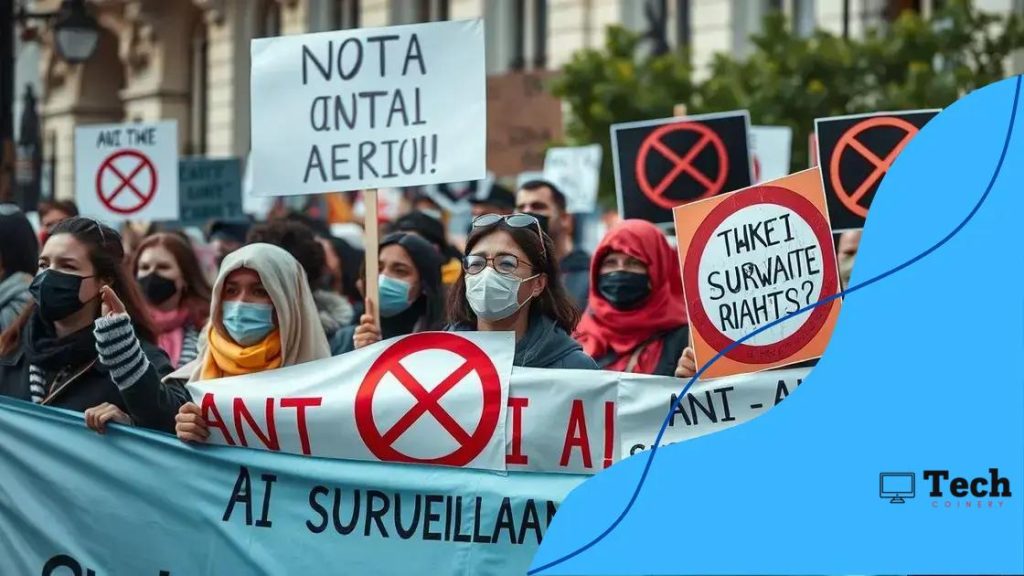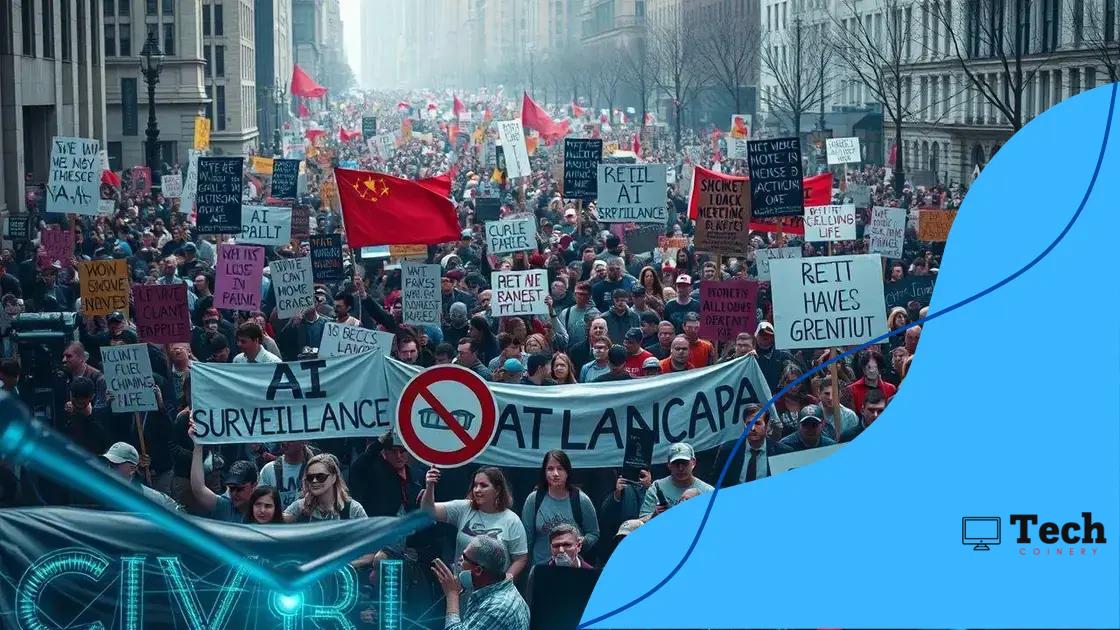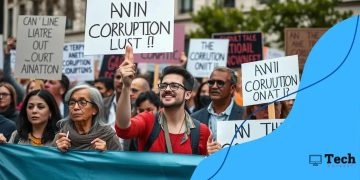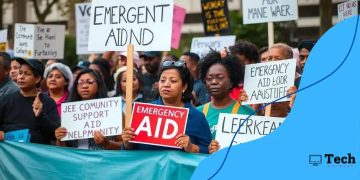Anti-AI surveillance rights protests: a growing movement

Anti-AI surveillance rights movements aim to protect individual privacy from invasive technologies, advocating for legal reforms and community engagement to ensure accountability and protection against constant monitoring.
Anti-AI surveillance rights protests are emerging worldwide as people unite against the creeping influence of artificial intelligence on their privacy. Have you wondered how this technology affects everyday lives? In this article, we will delve into the main concerns and activities surrounding these pivotal protests.
Overview of anti-AI surveillance rights
The anti-AI surveillance rights movement is becoming a vital part of the global dialogue about privacy and technology. As artificial intelligence tools become more advanced, concerns about their use in surveillance grow.
People are recognizing that their privacy rights are at stake. This movement pushes back against unchecked technological expansion. To understand the struggle, let’s explore the key aspects of this rapidly evolving situation.
Key Concerns
One major concern among activists is the lack of transparency regarding how AI is used for surveillance. Citizens are often unaware of when and how they are monitored. Another issue is the potential for misuse of data collected through surveillance systems.
- The proliferation of facial recognition technology.
- Potential bias in AI algorithms.
- Increase in government surveillance capabilities.
- The chilling effect on free speech.
The movement also focuses on advocating for laws that protect individuals from invasive technology. Activists argue for clear regulations that would govern the use of AI in public spaces.
Citizens are taking action. Many are joining protests to demand accountability and transparency. By raising awareness, they aim to empower others to join the fight for their rights.
Global Reactions
Internationally, countries are responding to the growing concerns. Some are implementing strict regulations on AI surveillance. Others are lagging behind, causing debates around the ethics of such technology. These responses highlight the urgency of the anti-AI surveillance rights movement. Globally, movements are building momentum, as people unite to demand their rights in an age dominated by technology.
Key issues driving the protests
The current wave of protests against AI surveillance is driven by several key issues that resonate deeply with citizens. As people become more aware of how technology impacts their lives, they are voicing their concerns.
One prominent issue is the threat that facial recognition technology poses to personal privacy. Many feel uncomfortable with the idea of being constantly monitored. This technology can identify individuals without their consent, creating a sense of unease in public spaces. Moreover, it is often introduced without proper regulation, raising serious ethical questions.
Data Privacy and Security
Another significant concern is the data privacy risks associated with surveillance systems. The collection and storage of personal data can lead to misuse and breaches. Activists argue that individuals should have control over their information. When data is mishandled, it can result in severe consequences for innocent people.
- Unauthorized access to personal information.
- Data breaches and leaks.
- Potential for profiling and discrimination.
- Lack of accountability from tech companies.
Additionally, there is a rising fear that these surveillance technologies could be used to suppress free speech. People worry that their voices will be silenced if they speak out against injustices. This chilling effect can prevent meaningful dialogue and activism from flourishing.
The Rise of Corporate Surveillance
The involvement of tech companies in these surveillance initiatives adds another layer of complexity. As businesses prioritize profit, ethical considerations often take a backseat. The rush to adopt AI tools without considering their implications poses risks to the public. Activists are calling for regulations that ensure companies act responsibly while integrating AI technology.
Moreover, the protests emphasize the need for community engagement in discussions about technology and ethics. When citizens collaborate, they can influence policy decisions more effectively. By raising awareness about these key issues, protesters aim to create a safer, more accountable digital environment for everyone.
Notable events and demonstrations

Throughout the rise of the anti-AI surveillance movement, several notable events and demonstrations have captured public attention. Each event reflects growing concern about how surveillance technologies impact individual freedoms.
One significant demonstration took place in San Francisco, where thousands gathered to protest the use of facial recognition in public places. Participants voiced their opposition to how this technology could infringe on personal privacy. The turnout showcased the community’s commitment to protecting their rights.
International Protests
The movement is not limited to San Francisco. Protests have occurred in cities around the world, emphasizing global solidarity. For instance, in London, activists staged a sit-in outside a government building to demand stricter regulations on AI surveillance. This event drew attention to the need for comprehensive legislation to safeguard personal privacy.
- Demonstrations in Berlin focused on corporate accountability.
- Rallies in New York highlighted the risks of unchecked surveillance.
- Protests in Paris addressed concerns about government overreach.
- Online campaigns have amplified grassroots efforts across various platforms.
Social media plays a crucial role in organizing these events. Activists use platforms to spread awareness and manage logistics for protests. Hashtags like #StopAIWatch and #PrivacyMatters have gained traction, helping rally support from diverse communities.
Impact on Legislation
These events not only raise awareness but also impact policy discussions. Lawmakers have begun to take notice of the protests. In response, some cities are implementing temporary bans on facial recognition technology while they evaluate its implications. The collective voice of the protesters pushes for more stringent regulations on surveillance practices.
Overall, the notable events and demonstrations highlight a growing movement that seeks to challenge the status quo. As people unite against the risks posed by AI surveillance, they create a platform for meaningful discussions about privacy and ethics in technology.
Voices from the front lines
Understanding the anti-AI surveillance rights movement requires hearing directly from those involved. Voices from the front lines give us insight into the experiences and motivations driving the protests. These individuals are not just activists; they are everyday people concerned about their rights and privacy.
Many participants share personal stories that reflect their fears regarding surveillance technology. For instance, some recall feeling uneasy when they learned about the extent of facial recognition being used in public areas. Their anxiety about being monitored without consent fuels their determination to advocate for change.
Personal Testimonies
Several attendees at protests have been vocal in media interviews, explaining why they joined the movement. One protester stated that they feel dehumanized by the idea of being reduced to data points. This sentiment resonates widely, as many believe that surveillance technology strips away their individuality.
- Concerns about being watched at all times.
- Fears of bias in AI technology.
- A commitment to protecting future generations’ rights.
- A call for transparency from both governments and corporations.
The stories of parents also emerge prominently. Many are worried about their children growing up in a world where their every move could be tracked. These voices highlight the emotional impact that surveillance technologies can have on families.
Community Impact
Beyond individual stories, community leaders articulate the broader implications of AI surveillance. They emphasize the need for collective action to safeguard civil liberties. By joining forces, communities aim to send a powerful message that they will not stand idly by while technology encroaches on their rights.
Activists encourage others to share their own experiences with surveillance, fostering a sense of unity. As more people voice their concerns, the movement strengthens, gaining momentum to challenge the status quo. These heartfelt stories from the front lines underscore the importance of fighting for privacy and civil liberties.
The future of surveillance and privacy rights
The future of surveillance and privacy rights is a topic filled with uncertainty and urgency. As technology continues to evolve, so too does the need for clear laws and regulations. Will our rights be adequately protected in an age dominated by AI?
Many experts believe that future advancements in AI could lead to even greater surveillance capabilities. This raises significant concerns for privacy advocates. The potential for misuse of technology exists, especially if there is a lack of oversight.
Legal Developments
In response to growing public concern, some lawmakers are considering new legislation aimed at protecting privacy rights. This includes potential bans on certain surveillance technologies. For instance, some cities have already enacted moratoriums on facial recognition tools.
- New privacy laws aimed at enhancing individual rights.
- Cities banning specific technologies seen as invasive.
- Proposals for community engagement in decision-making.
- Development of ethical guidelines for AI use.
The conversation around surveillance and privacy is becoming more inclusive. Activists are urging for community input on policies that affect their lives. They argue that those most impacted should have a say in how technology is used.
Public Awareness
Public awareness is another important factor. As more people become informed about how surveillance technologies operate, the pressure on policymakers to act increases. Grassroots movements continue to grow, further advocating for stronger protections.
In addition, educational campaigns aim to inform citizens about their rights related to surveillance. This knowledge empowers individuals to advocate for themselves and challenge unjust practices.
Ultimately, the future of privacy rights hinges on the ability of society to demand accountability. The trajectory of surveillance technology will largely depend on public engagement and legislative action. By remaining vigilant and proactive, communities can work towards a future where privacy rights are respected and upheld.
In conclusion, the fight for anti-AI surveillance rights is crucial for preserving our personal freedoms. As technology becomes more advanced, it is essential for us to stay informed and engaged. By uniting as a community, we can ensure our voices are heard. Advocacy and education are vital to protect our privacy rights in an increasingly surveilled world. It is a collective responsibility to demand accountability from both technology companies and lawmakers, working towards a future that prioritizes individual rights and ethics in technology.
FAQ – Frequently Asked Questions about Anti-AI Surveillance Rights
What are anti-AI surveillance rights?
Anti-AI surveillance rights refer to the protections and freedoms individuals seek to preserve their privacy against invasive surveillance technologies powered by artificial intelligence.
Why are people protesting against AI surveillance?
People are protesting against AI surveillance due to concerns about privacy invasion, potential misuse of data, and the risk of being constantly monitored without consent.
How can I get involved in the movement?
You can get involved by participating in local protests, joining organizations that advocate for privacy rights, and raising awareness through social media.
What legal changes are being proposed to protect privacy?
Proposed legal changes include banning certain surveillance technologies, implementing stricter regulations on data collection, and ensuring community input in technology deployment.






